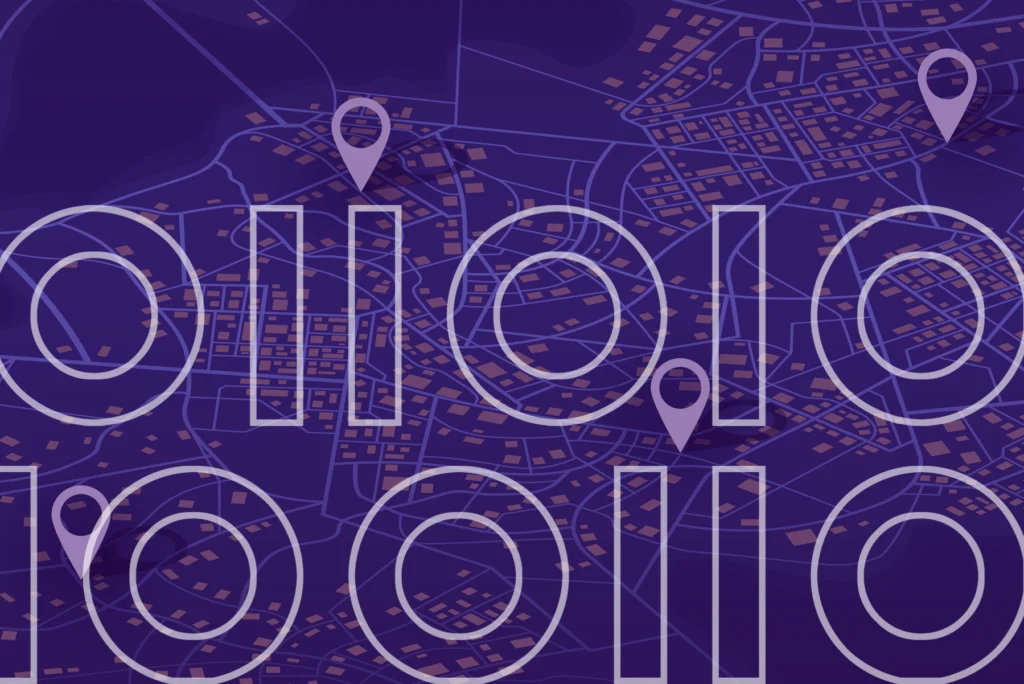A picture is worth a thousand words. As an example, here’s a graphical illustration of energy sources in the U.S. that clearly shows concentrations of solar energy usage in North Carolina, Massachusetts, and California. You can also see concentrations of solar power generation in southwestern Utah and surrounding Las Vegas, among other places. That’s the kind of information that could easily be lost in spreadsheets and tables yet is vital for informed decision-making.
By overlaying power generation sources with their locations, patterns emerge almost instantly. It takes little or no effort to identify the states (or regions) where solar power has gained momentum. Further analysis can lead to even more insights; you can visualize changes to the map over time (for example, you might better understand the effects of legislative changes in driving higher adoption of renewable energy sources).
There’s no doubt – location adds critical context. In this example, without understanding the geospatial context of energy usage, it becomes much more challenging to identify connections between where the adoption of solar power is gaining momentum and which factors may be influencing those trends.
In the same way, location intelligence adds context to virtually everything. And in doing so, it significantly expands the value of existing data and your capability to draw meaningful insights from it.
Today, companies invest heavily in location intelligence. Grand View Research estimates that the global market for geospatial analytics amounted to over $18 billion in 2023 and will grow at a compound annual rate of 15.6% through 2030. According to the 2023 Data Integrity Trends and Insights Report from the LeBow College of Business, 77% of companies have an average to very high reliance on location data.
Here are a few examples of how companies use location intelligence to inform better business decisions.
Targeted engagement with customers and prospects
One of the most common applications of location intelligence is targeted advertising.
Imagine that your business sells weight-loss products. It’s early January, and you want to advertise your product to all those people who just made New Year’s resolutions to get fit. One way to reach that audience would be to begin to identify consumers who recently began visiting a local gym. Location data can give you that information, enabling your business to drive targeted offers to exactly the right people.
Similarly, location data can help retailers better understand consumer behavior surrounding their omnichannel presence. Everyone knows that it is very common for consumers to shop for a product online before visiting a brick-and-mortar store to see the product up close and (hopefully) make a purchase. By linking online and offline consumer behaviors, business leaders are far better equipped to assess the efficacy of marketing campaigns and to design an omnichannel experience that results in higher profits.
Location-aware competitive analytics
Location intelligence can also provide a much richer view of the competitive landscape than might otherwise be apparent. This is especially true where the number and type of competitors may vary widely. In the restaurant industry, for example, competitors might be defined by category (e.g. fast food, family dining), by company (e.g. Yum Brands, which owns KFC, Pizza Hut, Taco Bell, and more), or more broadly as restaurants in general (or in some cases, grocery stores and gas stations offering Grab-and-Go/GNG offers).
Location intelligence enables you to visualize traffic patterns over time and understand the number of visitors to your locations and your competitors, including lifestyle preferences, income levels, and brand affinities, and how these insights change daily.
This information may provide deeper insights into competitive tactics. It can also provide a deeper understanding of trends over time to understand who is gaining and losing market share.
A visualization that shows the emergence of new competitors in your market area, correlating that with a decline in sales from specific neighborhoods, will provide a vivid illustration of how the competitive environment impacts your revenue.
This kind of analysis can also be used to refine performance evaluations and incentives based on external criteria that are beyond a location manager’s control.
Imagine that you operate a regional bank with multiple locations spread across several states. Branch managers are evaluated on the volume of new accounts opened at their location each year, among other things. It is not appropriate to compare the performance of a branch located in a rural community with that of an urban branch that deals with a highly mobile population or a branch in Miami with a branch in Seattle.
Location intelligence can refine the bank’s performance evaluation model in several ways. First, it can identify the mobility characteristics of the population surrounding each branch so that appropriate adjustments can be made to the financial goals set for mortgages, credit cards, or loans for example. Second, it can describe the competitive landscape for each branch in considerable detail. All other things being equal, a branch manager should be evaluated based on objective financial goals specific to the competitive and demographic composition of the trade area and market within which the branch is located. Location intelligence makes this possible.
Read our Report
Location Intelligence: The Data-Driven Paradigm Shift
Learn how organizations can use location data more effectively and transition from collecting location data coordinates to achieving location intelligence..
Location intelligence and retail site selection
One other popular use case for location intelligence is site selection. The site selection process involves assessing the suitability of potential retail locations and developing a financial model around a potential new branch, store, or restaurant.
Site selection calls for a rich body of mobility data that describes what demographic groups are frequenting a particular area and when. That is only a small piece of the overall picture, however.
Location intelligence can also give you a detailed picture of each potential site, including the parcel size, visibility to the street, the availability of parking, and even the history of the property including previous tenants and investors.
Geospatial data can also inform you about the socially relevant boundaries that might make a particular location more or less attractive. Location intelligence helps to clearly define and display catchment areas, map out potential competitors, and forecast growth or demographic changes within an area of interest.
You can track the short-term impacts due to weather events or road construction and layer them on to longer-term changes to a location’s surroundings. This way, retail businesses can better predict trends (e.g. gentrification or decline, increases in crime, etc.) that may impact future store performance.
The Precisely Data Integrity Suite helps organizations improve their enterprise location intelligence maturity by turning data into actionable insights using highly flexible and scalable location data management and spatial analytics. Precisely provides clients with powerful tools that open up new possibilities for gaining insights to achieve better business outcomes.
To learn how to use location data more effectively and transition from collecting location coordinates to achieving location intelligence, download the Forbes Insights report: Location Intelligence: The Data-Driven Paradigm Shift
Frequently asked questions
- What is location intelligence?
Location intelligence is a set of technologies that inform confident decisions and better business outcomes by leveraging location to add context to data. It unlocks your data’s hidden potential and reveals critical context, whether through spatial analytics or data enrichment, so you can trust your data for confident decision-making.
- Who uses location intelligence?
A wide range of industries and organizations use location intelligence. Insurance companies, for example, use it to assess risk, prevent fraud, and improve service levels. Retailers use it to refine site selection. Government agencies use location intelligence for urban planning, environmental monitoring, and emergency response. Telcos use it to plan network coverage, and marketers across all industries use it to better understand and reach customers and prospects with targeted messages.
- How can I ensure the most effective use of location intelligence?
Location intelligence starts with data, so you’ll need to make sure your analyses are built on data that’s accurate, consistent, and full of rich context. You can enrich your data with over 9000 attributes across 400 datasets from Precisely to ensure they your location intelligence tools return the data-driven insights you can trust.







